Gaussian Wake Deficit Models
This notebook reproduces the results of several papers presenting different versions of Gaussian wake models. They are presented in order of their publication dates.
Whilst PyWake defines wake models very generalisticly, some PyWake wind farm models have been defined to reproduce how they were originally published. For the Gaussian wake models these can be found in py_wake/literature/gaussian_models.py. That script is also a good starting point to check how you can setup your own Gaussian wind farm model.
[1]:
%load_ext autoreload
%autoreload 2
# install PyWake if needed
try:
import py_wake
except ModuleNotFoundError:
!pip install git+https://gitlab.windenergy.dtu.dk/TOPFARM/PyWake.git
# import general
import numpy as np
import matplotlib.pyplot as plt
import os
Bastankhah and Porté-Agel (2014)
This section reproduces results from
Bastankhah M and Porté-Agel F.: A new analytical model for wind-turbine wakes, J. Renew. Energy., 70:116-23, (2014), https://doi.org/10.1016/j.renene.2014.01.002
This paper presents a general definition of a wake model with Gaussian profile shape that obeys momentum conservation for an isolated turbine and can be seen as the foundation of the Gaussain wake model family. All subsequent model developments are based on the assumptions defined within this paper.
Site and wind turbine
Define dummy wind turbine with fixed \(C_T\) and simple site. We basically define a \(C_T\) curve that is constant by setting the values at very large and low wind speed. Power is not needed, therefore it is set to zero. The site is needed in the simulation but it has no influence on the computed deficit, as the deficit is substracted from the background mean-flow. The deficit model does not respond to changes in turbulence intensity.
[2]:
from py_wake.wind_turbines import WindTurbine
from py_wake.wind_turbines.power_ct_functions import PowerCtTabular
from py_wake.site._site import UniformSite
class Dummy(WindTurbine):
def __init__(self, name='dummy', ct=0.8, d=80., zh=70.):
WindTurbine.__init__(self, name=name, diameter=d,
hub_height=zh, powerCtFunction=PowerCtTabular([-100, 100], [0, 0], 'kW', [ct, ct]))
class BastankhahSite(UniformSite):
def __init__(self, ws=10., ti=0.04):
UniformSite.__init__(self, ti=ti, ws=ws)
Wind farm model
The paper is not really defining a wind farm model at all, but only a deficit model. However, in PyWake we need to define these to simulate wake flows, thus we defined a literature model that uses some reasonable presets, which is loaded here.
Note that this model requires the user to input the wake expansion factor, \(k\) (called \(k^*\) in the paper).
[3]:
from py_wake.literature.gaussian_models import Bastankhah_PorteAgel_2014
Validation
To validate our implementation we choose to compare data from Fig.7 of the paper, as this tests the wake shape, wake expansion and centre line deficit at the same time. Only wake profiles will be compared, as they provide the most quantitative comparison. Here we limit it to cases 2 and 3, computed at \(x/D = [3, 5]\), where \(D\) is the rotor diameter and \(x\) the downstream distance from the rotor plane. This is sufficient to demonstrate that the model is implemented correctly.
The inputs for the simulation are taken from Table 1 and Fig. 7. Table 1 provides wind turbine and inflow parameters (shear is not needed, for reasons mentioned before) and Fig. 4 provides the wake expansion factors for each case that were fitted to LES data. Note that the initial wake size, \(\epsilon\), is not taken from Fig. 4, but computed as defined in the paper in Eq.(21) using \(0.2 \sqrt{\beta}\).
Case definition
[4]:
# expansion factors (taken from Fig.4)
ks = [0.055, 0.040]
# hub height wind speed
ws = 9.
# rotor diameter
d = 80.
# rotor hub height
zh = 70.
# rotor thrust coefficient
ct = 0.8
Fig. 7 reproduction
Load reference data
[5]:
# load reference data extracted manually from Fig.7 of the paper (only cases 2 and 3 at x/d=3, 5)
dat = np.genfromtxt(os.path.join('data', 'Gaussian', 'Basthankhah_PorteAgel_2014_Fig7.csv'),
skip_header=2, delimiter=',')
cases = ['case_2', 'case_3']
# downstream position
xd = [3., 5.]
names = ['LES', 'model']
ref_fig7 = {}
for i, case in enumerate(cases):
tmp = {}
for j, name in enumerate(names):
tmp2 = np.zeros((dat.shape[0], len(xd), 2))
for k in range(len(xd)):
col = 8 * i + 2 * j + 4 * k
tmp2[:, k, [0, 1]] = dat[:, [col, col + 1]]
tmp[name] = tmp2
ref_fig7[case] = tmp
Simulation and plotting
[6]:
from py_wake.flow_map import XZGrid
# normal point distribution for plotting
zd = np.linspace(0.2, 2., 201)
# define wind turbine and site
wt = Dummy(ct=ct, d=d, zh=zh)
site = BastankhahSite(ws=ws)
fig, ax = plt.subplots(2, 2, sharey=True, figsize=(8, 5))
for i, (case, k) in enumerate(zip(cases, ks)):
# wind farm model, you need to set the expansion factor, k
wfm = Bastankhah_PorteAgel_2014(site, wt, k)
# simulation
sim = wfm(x=[0.], y=[0.], wd=270., ws=ws)
# wake profiles
u = np.squeeze(sim.flow_map(XZGrid(y=0.0, x=np.array(xd) * d, z=zd * d)).WS_eff)
for j in range(len(xd)):
ax[i, j].plot(ref_fig7[case]['model'][:, j, 0], ref_fig7[case]['model'][:, j, 1], 'k-', label='Model (2014)')
ax[i, j].plot(ref_fig7[case]['LES'][:, j, 0], ref_fig7[case]['LES'][:, j, 1], 'o', color=0.5 * np.ones(3), label='LES (2014)')
ax[i, j].plot(1. - u[:, j] / ws, zd, 'b:', label='PyWake')
if i == 0:
ax[i, j].set_title(r'$x/D={:.0f}$'.format(xd[j]))
if i == 1:
ax[i, j].set_xlabel(r'$\Delta u/ U_{\infty}$')
if j == 0:
ax[i, j].set_ylabel(r'$z/D$')
ax[i, j].grid(lw=0.5, alpha=0.3)
lines, labels = ax[0, 0].get_legend_handles_labels()
leg = fig.legend(lines, labels, loc='upper right')
leg.get_frame().set_alpha(1.0)
fig.tight_layout()
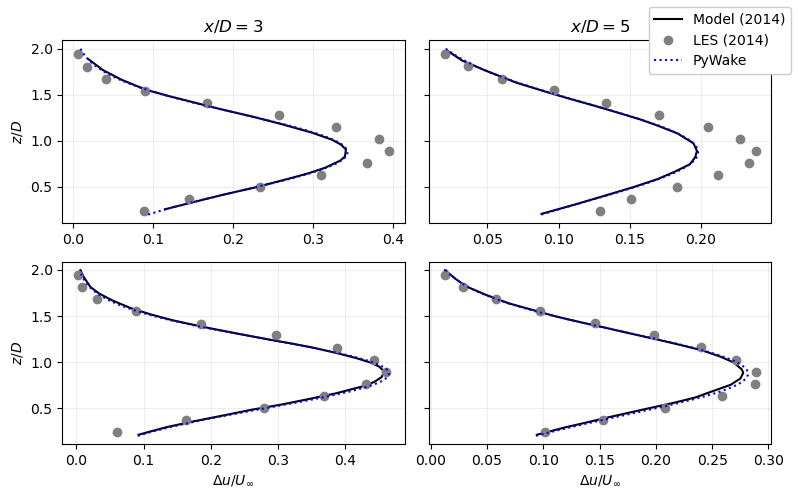
The agreement between PyWake and the paper is perfect, with any deviations being easily attributed to the manual extraction of data from the paper (the plot is rather small).
Niayifar and Porté-Agel (2016)
This section reproduces results from
Niayifar A and Porté-Agel F.: Analytical Modeling of Wind Farms: A New Approach for Power Prediction, Energies, 9(9), 741, (2016), https://doi.org/10.3390/en9090741
This paper defines a wind farm model using the Gaussian wake model by Bastankhah and Porté-Agel (2014). Important additions are:
inflow turbulence intensity depended wake expansion
linear wake superposition
Site and wind turbine
The paper presents results for Horns Rev 1, which are available in PyWake.
[7]:
from py_wake.examples.data.hornsrev1 import Hornsrev1Site, V80, wt_x, wt_y
v80_pw = V80()
site = Hornsrev1Site()
Unfortunatley it remains somewhat unclear what thrust and power curves the authors used for the Vestas V-80 in their simulations. Only after testing a lot of different possibilities were we able to reproduce their results.
They present a fitted power curve in Fig. 2, but also show 2 more pairs of curves in Fig. 4 (observed and predicted) without clearly stating which curves were exactly used. Here we show how much these different V-80 definitions differ and also compare it to the one in PyWake. From Fig. 4 only the curves labelled predicted were extracted manually from the paper. In Fig. 2 no thrust curve has been defined so we used the one from Fig. 4, instead. Yet there is another issue in that case. The curves in Fig. 4 only start at a wind speed of 5 m/s, but the one in Fig. 4 starts at 4 m/s, the we take the \(C_T\) from Fig. 4 but need to add another value at 4 m/s, which is simply set to the \(C_T\) at 5 m/s.
[8]:
# load reference data extracted manually from Fig.5 of the paper
dat = np.genfromtxt(os.path.join('data', 'Gaussian', 'Niayifar_PorteAgel_2016_Fig4.csv'),
skip_header=2, delimiter=',')
v80_2016_fig4 = WindTurbine(name="V80 (2016: Fig.4)", diameter=80., hub_height=70.,
powerCtFunction=PowerCtTabular(dat[:, 2], dat[:, 3], 'MW', dat[:, 1]), method='pchip')
# Fig. 2 provides a fit for power but not CT, so we take the CT from Fig. 4
# but need to add another value at 4 m/s, which is simply set to the CT at 5 m/s
ws = np.hstack((np.array([3.9, 4.0]), dat[1:, 2]))
ct = np.hstack((np.array([0.0, dat[1, 1]]), dat[1:, 1]))
power = (0.17819 * ws**5 - 6.5198 * ws**4 + 90.623 * ws**3 - 574.62 * ws**2 + 1727.2 * ws - 1975)
power[power > 2000.] = 2000.
power[ws < 4] = 0.0
power[ws > 20] = 0.0
v80_2016_fig2 = WindTurbine(name="V80 (2016: Fig.2)", diameter=80., hub_height=70.,
powerCtFunction=PowerCtTabular(ws, power, 'kW', ct), method='pchip')
[9]:
from py_wake.utils.plotting import setup_plot
ws = np.linspace(0, 30, 121)
fig, ax = plt.subplots(2, 1, sharex=True)
plt.figure()
ax[0].plot(ws, v80_pw.ct(ws), '-', label='PyWake')
ax[0].plot(ws, v80_2016_fig4.ct(ws), '-', label='Fig.4 (2016)')
ax[0].plot(ws, v80_2016_fig2.ct(ws), '-', label='Fig.2 (2016)')
ax[0].grid(lw=0.5, alpha=0.3)
ax[0].set_ylabel('Thrust coefficient [-]')
ax[1].plot(ws, v80_pw.power(ws) / 1.e6, '-', label='V80 PyWake')
ax[1].plot(ws, v80_2016_fig4.power(ws) / 1.e6, '-', label='Fig.4 (2016)')
ax[1].plot(ws, v80_2016_fig2.power(ws) / 1.e6, '-', label='Fig.2 (2016)')
ax[1].grid(lw=0.5, alpha=0.3)
ax[1].set_ylabel('Power [MW]')
ax[1].set_xlabel('Wind speed [m/s]')
fig.suptitle('Vestas V-80')
ax[1].legend()
[9]:
<matplotlib.legend.Legend at 0x7f68186c0370>
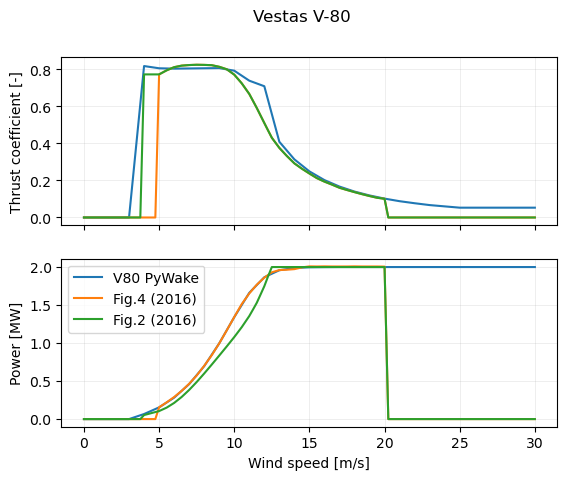
<Figure size 640x480 with 0 Axes>
In the following plot we recreate Fig. 2 but adding the power curves from PyWake and Fig. 4 to show the difference between them. For some reason the power is lower in Fig. 2.
[10]:
ws = np.linspace(4, 10, 121)
plt.figure()
plt.plot(ws, v80_pw.power(ws) / 1.e3, '-', label='V80 PyWake')
plt.plot(ws, v80_2016_fig4.power(ws) / 1.e3, '-', label='V80 Fig.4 (2016)')
plt.plot(ws, v80_2016_fig2.power(ws) / 1.e3, '-', label='V80 Fig.2 (2016)')
plt.legend()
plt.grid(lw=0.5, alpha=0.3)
plt.ylabel('Power [kW]')
plt.xlabel('Wind speed [m/s]')
[10]:
Text(0.5, 0, 'Wind speed [m/s]')
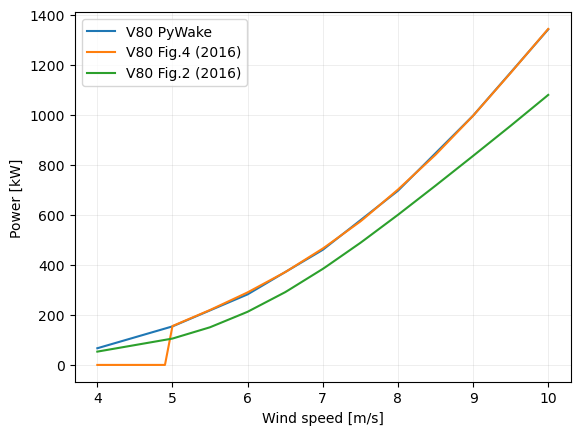
Wind farm model
The wind farm model uses the Gaussian wake model together with linear wake deficit summation and a wake expansion factor that respionds to the local inflow turbulence intensity (TI). The added TI is computed using the model by Crespo and Hernandez (1996) with slightly modified constants. The square of the local TI is defined as the sum of the ambient TI and the maximum weighted (by wake-rotor overleap area) added TI.
[11]:
from py_wake.literature.gaussian_models import Niayifar_PorteAgel_2016
Validation
Case definition
[12]:
# hub height wind speed
ws = 8.0
# ambient turbulence intensity
ti = 0.077
# wind directions
wd = np.arange(173., 354., 1.)
PyWake Simulation
The paper does not cearly state how the rotor reference velocity is computed (used to scale the deficit and look-up the thrust and power). So here we try both, the PyWake default, which is the RotorCenter() method, and the GaussianOverlapAvgModel() (set as default in the literature model, but set here explicitly for clarity), which averages velocities over the rotor disc. This will also demonstrate how the rotor-averaging can influence your results. Furthermore, we test the different
definitions of the Vestas V-80 given in the paper.
[13]:
from py_wake.rotor_avg_models import RotorCenter
from py_wake.rotor_avg_models.gaussian_overlap_model import GaussianOverlapAvgModel
# instantiate wind farm model
wfm_rc = Niayifar_PorteAgel_2016(site, v80_2016_fig4, rotorAvgModel=RotorCenter())
wfm_ga = Niayifar_PorteAgel_2016(site, v80_2016_fig4, rotorAvgModel=GaussianOverlapAvgModel())
wfm_ga_fig2 = Niayifar_PorteAgel_2016(site, v80_2016_fig2, rotorAvgModel=GaussianOverlapAvgModel())
# run simulation
sim_rc = wfm_rc(wt_x, wt_y, TI=ti, ws=ws, wd=wd)
sim_ga = wfm_ga(wt_x, wt_y, TI=ti, ws=ws, wd=wd)
sim_ga_fig2 = wfm_ga_fig2(wt_x, wt_y, TI=ti, ws=ws, wd=wd)
Reproduction of Fig. 5
This figure compares the wind farm efficieny predicted by LES simulations and the Gaussian wind farm model at a single wind speed.
Load reference data
[14]:
# load reference data extracted manually from Fig.5 of the paper
dat = np.genfromtxt(os.path.join('data', 'Gaussian', 'Niayifar_PorteAgel_2016_Fig5.csv'),
skip_header=2, delimiter=',')
ref_fig5 = {}
ref_fig5['LES'] = dat[:, :2]
ref_fig5['model'] = dat[:, 2:]
Plotting
[15]:
plt.figure()
plt.plot(ref_fig5['LES'][:, 0], ref_fig5['LES'][:, 1], 'ro-', label='LES (2016)')
plt.plot(ref_fig5['model'][:, 0], ref_fig5['model'][:, 1], 'b-', label='Model (2016)')
plt.plot(wd, sim_rc.Power.sum(axis=0)[:, 0] / (len(wt_x) * v80_2016_fig4.power(ws=ws)), 'k--', label='PyWake | WT Fig 4. | RotorCentre')
plt.plot(wd, sim_ga.Power.sum(axis=0)[:, 0] / (len(wt_x) * v80_2016_fig4.power(ws=ws)), 'c--', label='PyWake | WT Fig 4. | GaussianAvg')
plt.plot(wd, sim_ga_fig2.Power.sum(axis=0)[:, 0] / (len(wt_x) * v80_2016_fig2.power(ws=ws)), 'm:', label='PyWake | WT Fig 2. | GaussianAvg')
plt.axis([160, 360, 0.4, 1.0])
plt.xlabel('Wind direction [deg]')
plt.ylabel('Wind farm efficiency [-]')
plt.title('Horns Rev 1 | $U_{hub}=8$ m/s | $I_{\infty}=7.7$%')
plt.grid('on', lw=0.5, alpha=0.5)
plt.legend()
[15]:
<matplotlib.legend.Legend at 0x7f68444c5b70>
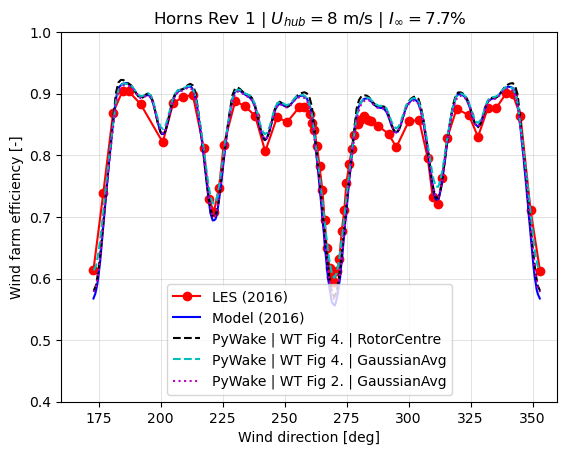
The agreement is nearly perfect. Interestingly using the GaussianOverlapAvgModel() the results are closer to the LES predictions when the turbine rows are aligning ie. in situations of full-wake.
Reproduction Fig. 6
This figure compares the power production evolution along a row of turbines for a wind direction of 270 degrees, constiuting a full-wake situation.
Load reference data
[16]:
# load reference data extracted manually from Fig.5 of the paper
dat = np.genfromtxt(os.path.join('data', 'Gaussian', 'Niayifar_PorteAgel_2016_Fig6.csv'),
skip_header=2, delimiter=',')
ref_fig6 = {}
ref_fig6['model'] = dat[:, :2]
ref_fig6['LES'] = dat[:, 2:]
The turbine numbering is different in the paper than in PyWake, but they mention that they average over columns 2, 3 and 4 (a column in the paper refers to turbine row spanning from east to west, with the southernmost being column 1). The following plot shows the turbine rows to be selected for the plot.
[17]:
plt.figure()
plt.plot(wt_x, wt_y, 'o', label='Horns Rev 1')
for i in range(3):
plt.plot(wt_x[8 - (i + 2)::8], wt_y[8 - (i + 2)::8], '-', label='column {}'.format(i + 1))
plt.grid('on', lw=0.5, alpha=0.5)
leg = plt.legend()
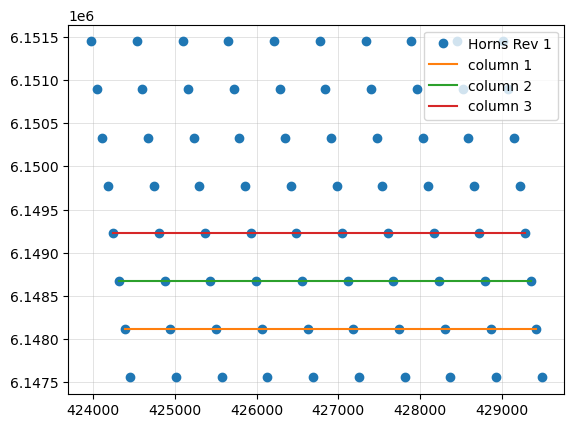
Plot Fig. 6
[18]:
plt.figure()
iwt = np.linspace(1, 10, 10)
plt.plot(iwt, ref_fig6['LES'][:, 1], 'ro-', label='LES (2016)')
plt.plot(iwt, ref_fig6['model'][:, 1], 'bv-', label='Model (2016)')
# select wind direction 270 degrees
iwd = 97
# select columns
pp = np.zeros((3, 10, 3))
for i in range(pp.shape[0]):
pp[i, :, 0] = sim_rc.Power.values[8 - (i + 2)::8, iwd, 0]
pp[i, :, 1] = sim_ga.Power.values[8 - (i + 2)::8, iwd, 0]
pp[i, :, 2] = sim_ga_fig2.Power.values[8 - (i + 2)::8, iwd, 0]
# average over columns
pp_avg = np.mean(pp, axis=0)
# plot results
plt.plot(iwt, pp_avg[:, 0] / pp_avg[0, 0], 'k.--', label='PyWake | WT Fig 4. | RotorCenter')
plt.plot(iwt, pp_avg[:, 1] / pp_avg[0, 1], 'c.--', label='PyWake | WT Fig 4. | GaussianAvg')
plt.plot(iwt, pp_avg[:, 2] / pp_avg[0, 2], 'm.--', label='PyWake | WT Fig 2. | GaussianAvg')
plt.xlabel('Turbine number [-]')
plt.ylabel('Normalised power [-]')
plt.title('Horns Rev 1 | $U_{hub}=8$ m/s | $I_{\infty}=7.7$% | Cols. 2-4 | ' + '{:.0f} deg'.format(sim_ga.wd.values[iwd]))
plt.grid('on', lw=0.5, alpha=0.5)
plt.legend()
[18]:
<matplotlib.legend.Legend at 0x7f68444b6140>
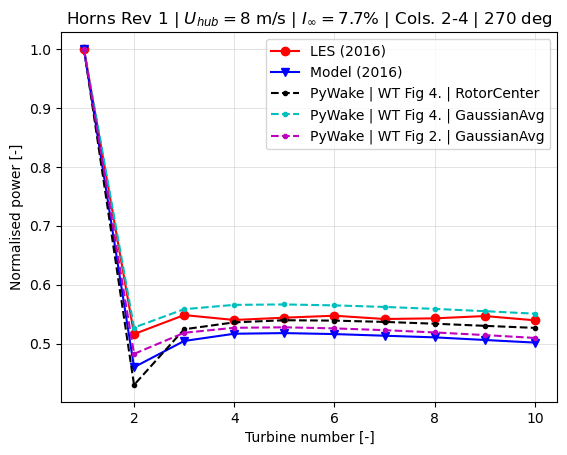
Following some detective work, it seems that some sort of rotor-averaging was indeed used by the authors, as indicated by the PyWake curves with GaussianOverlapAvgModel() having similar shapes. The slight offset between PyWake and the results from the paper might be due to differences in the thrust curve, specific rotor-averaging method used or related to the manual extraction of the data from the figure.
Carbajo Fuertes et al. (2018)
This section presents our implementation of the modifications presented in
Carbajo Fuertes, F., Markfort, C. D., & Porté-Agel, F.: Wind turbine wake characterization with nacelle-mounted wind lidars for analytical wake model validation, Remote Sensing, 10(5), 668, (2018), https://doi.org/10.3390/rs10050668
to the Gaussian model by Niayifar et al. (2016). In this paper they use wind lidar measurements taken in the wake of a 2.5MW turbine to retune the expression for the wake width, \(\sigma\), in the Gaussian model. An important change is that the initial wake width, \(\epsilon\), becomes a function of the wake expansion rate, \(k\), and thereby becomes dependant on turbulence intensity.
Comparison
To show the impact of the modification we rerun the Horns Rev 1 case used by Niayifar and PorteAgel (2016).
[19]:
from py_wake.literature.gaussian_models import CarbajoFuertes_etal_2018
# instantiate
wfm_16 = Niayifar_PorteAgel_2016(site, v80_2016_fig2)
wfm_18 = CarbajoFuertes_etal_2018(site, v80_2016_fig2)
# run simulation
sim_16 = wfm_16(wt_x, wt_y, TI=ti, ws=ws, wd=wd)
sim_18 = wfm_18(wt_x, wt_y, TI=ti, ws=ws, wd=wd)
Wind farm efficiency
[20]:
plt.figure()
plt.plot(ref_fig5['LES'][:, 0], ref_fig5['LES'][:, 1], 'ro-', label='LES (2016)')
plt.plot(wd, sim_16.Power.sum(axis=0)[:, 0] / (len(wt_x) * v80_2016_fig2.power(ws=ws)), 'b-', label='Niayifar_PorteAgel_2016')
plt.plot(wd, sim_18.Power.sum(axis=0)[:, 0] / (len(wt_x) * v80_2016_fig2.power(ws=ws)), 'g-', label='CarbajoFuertes_etal_2018')
plt.axis([160, 360, 0.4, 1.0])
plt.xlabel('Wind direction [deg]')
plt.ylabel('Wind farm efficiency [-]')
plt.title('Horns Rev 1 | $U_{hub}=8$ m/s | $I_{\infty}=7.7$%')
plt.grid('on', lw=0.5, alpha=0.5)
plt.legend()
[20]:
<matplotlib.legend.Legend at 0x7f681868a4d0>
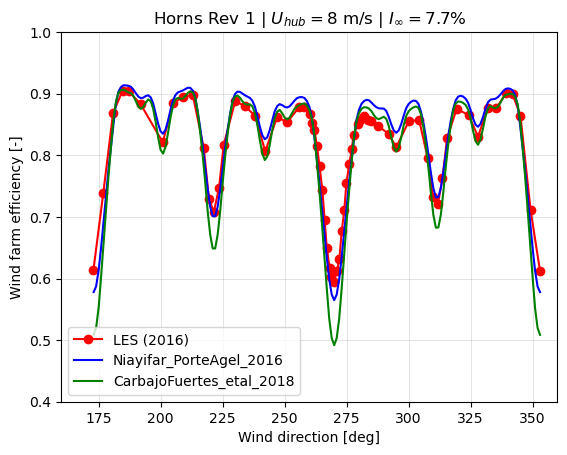
Power variation
[21]:
plt.figure()
iwt = np.linspace(1, 10, 10)
plt.plot(iwt, ref_fig6['LES'][:, 1], 'ro-', label='LES (2016)')
# select wind direction 270 degrees
iwd = 97
# select columns
pp = np.zeros((3, 10, 3))
for i in range(pp.shape[0]):
pp[i, :, 0] = sim_16.Power.values[8 - (i + 2)::8, iwd, 0]
pp[i, :, 1] = sim_18.Power.values[8 - (i + 2)::8, iwd, 0]
# average over columns
pp_avg = np.mean(pp, axis=0)
# plot results
plt.plot(iwt, pp_avg[:, 0] / pp_avg[0, 0], 'b.-', label='Niayifar_PorteAgel_2016')
plt.plot(iwt, pp_avg[:, 1] / pp_avg[0, 1], 'g.-', label='CarbajoFuertes_etal_2018')
plt.xlabel('Turbine number [-]')
plt.ylabel('Normalised power [-]')
plt.title('Horns Rev 1 | $U_{hub}=8$ m/s | $I_{\infty}=7.7$% | Cols. 2-4 | ' + '{:.0f} deg'.format(sim_16.wd.values[iwd]))
plt.grid('on', lw=0.5, alpha=0.5)
plt.legend()
[21]:
<matplotlib.legend.Legend at 0x7f681852bbb0>
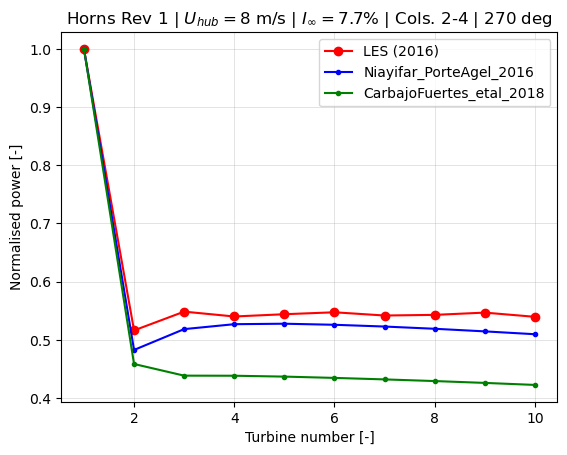
For aligned, deep-wake situations the updates to the model seem to overpredict losses, yet in any other situation it provides efficiency estimates close to the LES simulations.
Zong and Porté-Agel (2020)
This section reproduces results from
Zong H. and Porté-Agel F.: A momentum-conserving wake superposition method for wind farm power prediction, J. Fluid Mech., 889, A8, (2020), https://doi.org/10.1017/jfm.2020.77
The main focus of this paper is a momentum-conserving wake superposition model, however it also presents yet another version of a Gaussian model. Indeed without modifying the near-wake behaviour of the original Guassian model, the superposition model leads to bizarre results in the near-wake region.
Extension of the Niayifar et al. (2016) implementation with adapted Shapiro wake model components, namely a gradual growth of the thrust force and an expansion factor not falling below the rotor diameter. Shapiro modelled the pressure and thrust force as a combined momentum source, that are distributed in the streamwise direction with a Gaussian kernel with a certain characteristic length. As a result the induction changes following an error function. Zong chose to use a characteristic length of \(D/\sqrt{2}\) and applies it directly to the thrust not the induction as Shapiro. This leads to the full thrust being active only \(2D\) downstream of the turbine. Zong’s wake width expression is inspired by Shapiro’s, however the start of the linear wake expansion region (far-wake) was related to the near-wake length by Vermeulen (1980). The initial wake width, \(\epsilon\), in the original Gaussian model was taken to be a function of \(C_T\) is now a constant as proposed by Bastankhah et al. (2016), as the near-wake length now effectively dictates the origin of the far-wake.
Validation
Fig. 3 reproduction
This reproduces the results from a wind tunnel measurement campaign with four aligned miniature wind turbines.
Case definitions
[22]:
# hub height wind speed
ws = 4.9
# rotor diameter
d = .15
# rotor hub height
zh = 0.125
# rotor thrust coefficient
ct = 0.82
# turbulence intensity
ti = 0.06
# turbine tip speed ratio needed in near-wake length computation (personal communication)
lam = 3.8
Instantiate site and wind turbine
[23]:
# define wind turbine and site
wt = Dummy(ct=ct, d=d, zh=zh)
site = BastankhahSite(ws=ws, ti=ti)
# turbine positions
wt_y = [0., 0., 0., 0.]
wt_x = [0., 5. * d, 10. * d, 15. * d]
As in the paper we will run PyWake with different superposition models. Note how both effective_ws and effective_ti need to be set to False to reproduce what Zong et al. refer to as the one by Katic et al. or Method B in their paper. By default the superposition method by Zong is used, which in PyWake is called WeightedSum(), as it weights deficits using the convection velocity ratio.
[24]:
from py_wake.literature.gaussian_models import Zong_PorteAgel_2020
from py_wake.superposition_models import LinearSum, SquaredSum
from py_wake.flow_map import Points
from py_wake.rotor_avg_models import CGIRotorAvg
wfm_names = ['SquaredSum', 'LinearSum', 'WeightedSum']
wfms = [Zong_PorteAgel_2020(site, wt, lam=lam,
superpositionModel=SquaredSum(),
rotorAvgModel=GaussianOverlapAvgModel(),
use_effective_ws=False, use_effective_ti=False),
Zong_PorteAgel_2020(site, wt, lam=lam,
superpositionModel=LinearSum(),
rotorAvgModel=GaussianOverlapAvgModel()),
Zong_PorteAgel_2020(site, wt, lam=lam,
rotorAvgModel=CGIRotorAvg(21))]
Load reference data, provided by the authors
[25]:
# load reference data extracted manually from Fig.5 of the paper
ref_fig3 = np.genfromtxt(os.path.join('data', 'Gaussian', 'Zong_PorteAgel_2020_Fig3.csv'),
skip_header=1, delimiter=',')
[26]:
plt.figure()
# Reference data
plt.plot(ref_fig3[:, 0], ref_fig3[:, 2], 'g-', label='SquaredSum (2020: MB)')
plt.plot(ref_fig3[:, 0], ref_fig3[:, 3], 'm-', label='LinearSum (2020: MD)')
plt.plot(ref_fig3[:, 0], ref_fig3[:, 5], 'b-', label='WeightedSum (2020: NM)')
plt.plot(ref_fig3[:, 0], ref_fig3[:, 6], 'k-', label='PIV (2020)')
# PyWake
x = np.linspace(0, 15, 5 * 15 + 1) * d
lcs = ['g', 'm', 'b']
for wfm, wfm_name, lc in zip(wfms, wfm_names, lcs):
sim = wfm(wt_x, wt_y, ws=ws, wd=270., TI=ti)
u = np.squeeze(sim.flow_map(Points(x=x, y=np.zeros_like(x), h=zh * np.ones_like(x))).WS_eff.values)
plt.plot(x / d, u / ws, lc + '.', label='PyWake | ' + wfm_name)
plt.title('EPFL Wind Tunnel | $U_{hub}=4.9$ m/s | $I_{\infty}=' + '{:.0f}$%'.format(ti * 1.e2))
plt.grid('on', lw=0.5, alpha=0.5)
plt.axis([0., 15., 0., 1.0])
plt.legend()
[26]:
<matplotlib.legend.Legend at 0x7f6818579fc0>
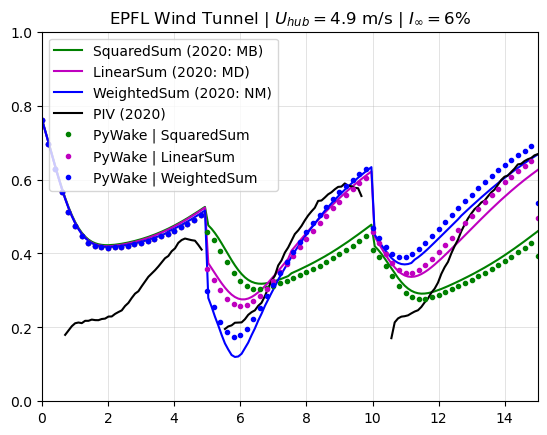
The Zong wake deficit is correctly implemented as demonstrated by near-perfect match in the wake of the first turbine. The wake growth seems a little slower, but without knowing the exact expression used for the near-wake length (here we use the one presented by Niayifar et al. (2016) in Eq.(11)) it is difficult to get exactly the same (one can increase \(I_{\infty}\) ever so slightly and they will line-up). After the second turbine there are slight differences between the classic superposition models, most likely due differences in the rotor-averaging method (not disclosed in the paper).
